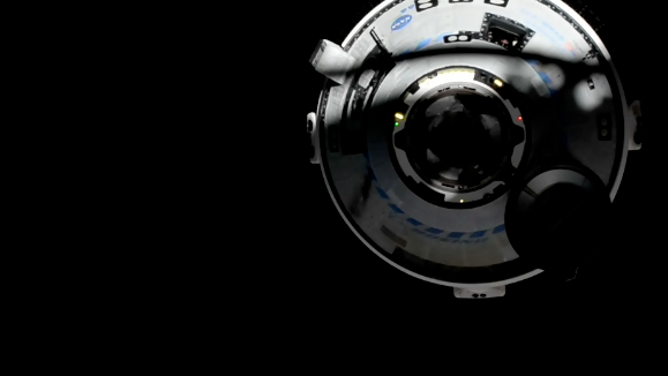Boeing Starliner departure from space station remains delayed due to 'complicated' issues
After arriving at the International Space Station on June 6, astronauts Suni Williams and Butch Wilmore were expected to spend about eight days on the orbiting laboratory. However, issues with Starliner's hardware prompted NASA managers to delay their return date.
Boeing Starliner launches 2 NASA astronauts into orbit for first time
ULA's Atlas V rocket launched on Wednesday morning from Florida sending the first Boeing Starliner capsule with crew into orbit. NASA Astronauts Butch Wilmore and Suni Williams are conducting the crew flight test of Starliner and will spend about a week at the International Space Station.
Boeing Starliner's first astronaut crew will spend additional weeks in orbit as ground teams complete more data reviews of ongoing issues with the spacecraft.
Starliner launched NASA astronauts Suni Williams and Butch Wilmore on June 5 from Cape Canaveral, Florida, on a United Launch Alliance Atlas V rocket. The pair is conducting the Crew Flight Test of Boeing's Starliner spacecraft to certify the vehicle to fly crew as part of NASA's Commercial Crew Program. SpaceX's Crew Dragon vehicle also flies astronauts as part of the NASA program and is preparing for its ninth NASA astronaut mission this summer.
BOEING STARLINER LIFTS OFF FLYING NASA ASTRONAUTS FOR FIRST TIME
After arriving at the International Space Station on June 6, Williams and Wilmore were expected to spend about eight days on the orbiting laboratory. However, issues with Starliner's hardware prompted NASA managers to delay their return date several times.

NASA astronauts Butch Wilmore, left, and Suni Williams, wearing Boeing spacesuits, are seen as they prepare to depart the Neil A. Armstrong Operations and Checkout Building for Launch Complex 41 on Cape Canaveral Space Force Station to board the Boeing CST-100 Starliner spacecraft for the Crew Flight Test launch, Wednesday, June 5, 2024, at NASA’s Kennedy Space Center in Florida. Photo Credit: (NASA/Joel Kowsky)
(NASA)
The latest delay was announced Friday when the space agency alluded to the astronauts' return not happening before July 2.
"We are taking our time and following our standard mission management team process," Steve Stich, manager of NASA’s Commercial Crew Program, said in a statement. "We are letting the data drive our decision making relative to managing the small helium system leaks and thruster performance we observed during rendezvous and docking. Additionally, given the duration of the mission, it is appropriate for us to complete an agency-level review, similar to what was done ahead of the NASA’s SpaceX Demo-2 return after two months on orbit, to document the agency’s formal acceptance on proceeding as planned."
After the Starliner undocks from the ISS, it will land in White Sands Space Harbor in New Mexico.
Despite extending their mission more than twice the original timeline, the astronauts are in good spirits.
"They've been very positive about the whole thing," Stich said. "They love Starliner. They love being in the vehicle. They love being on the ISS. I think, you know, if you ask Butch and Suni, they might want to stay for a long period."
Astronauts provide on orbit tour of Boeing Starliner
NASA Astronauts Butch Wilmore and Suni Williams gave a tour of the Boeing Starliner spacecraft two days after docking at the International Space Station.
Path forward to Starliner's landing
Teams recently completed a hot fire of the Starliner spacecraft's thrusters with the vehicle docked at the ISS to troubleshoot the issues encountered during docking when five thrusters failed.
BOEING STARLINER SPACECRAFT DOCKS AT ISS WITH NASA ASTRONAUTS AFTER DRAMATIC APPROACH
Stich said the best place to test these issues is in orbit because they can replicate the thermal conditions on Starliner exactly, unlike simulations on Earth. The thruster issue is limited to the spacecraft's service module, which does not return to Earth with the crew module.

A view of Boeing's Starliner spacecraft from the International Space Station as the vehicle comes in for docking on June 6, 2024.
(NASA)
When it returns to Earth, Starliner will face two big milestones that require the thrusters to orient the vehicle for landing. Teams are working to understand how the thrusters will perform during the deorbit burn.
NASA and Boeing's engineers continue to analyze five helium leaks discovered between the launch and docking. Stich said NASA's Marshall Space Flight Center teams are doing field testing to simulate the leak rates.
The spacecraft needs 7 hours of helium and has 70 hours of margin to reach the deorbit burn.
"The path going forward is to continue to look at the helium system, continue to try to understand what's happening, again, look at simulations for the remainder of the flight," Sitch said. "What's our demand? What if we wave off? And what does that mean for the system?"
NASA said the crew is not on a confined schedule to leave the space station since there are plenty of supplies available in orbit.

